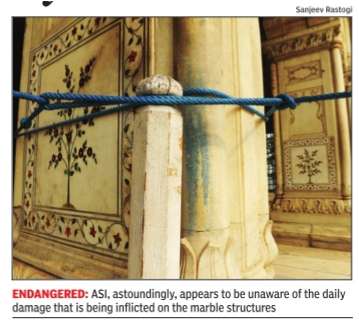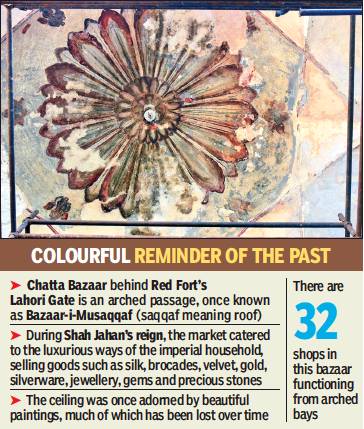Delhi: Red Fort
(→2016: some decay) |
|||
| Line 28: | Line 28: | ||
The Diwan-e-Khas, or hall of private audience, was used by Mughal emperors to meet the nobility and was grandly decorated, with the lower portion of the piers bearing inlaid floral motifs and the upper portions gilded and painted.“The ceiling, which was originally inlaid with silver and gold, was stripped bare by the Jats and Marathas during the successive crises of the empire,“ informed a historian.The interiors of the audience hall were plundered in the aftermath of the war of 1857, and the throne, carpets and many other artefacts went missing. The current ceiling was installed in 1911. | The Diwan-e-Khas, or hall of private audience, was used by Mughal emperors to meet the nobility and was grandly decorated, with the lower portion of the piers bearing inlaid floral motifs and the upper portions gilded and painted.“The ceiling, which was originally inlaid with silver and gold, was stripped bare by the Jats and Marathas during the successive crises of the empire,“ informed a historian.The interiors of the audience hall were plundered in the aftermath of the war of 1857, and the throne, carpets and many other artefacts went missing. The current ceiling was installed in 1911. | ||
| + | |||
| + | =Architecture, décor= | ||
| + | == Chatta Bazaar: paintings== | ||
| + | [https://epaper.timesgroup.com/Olive/ODN/TimesOfIndia/shared/ShowArticle.aspx?doc=TOIDEL%2F2018%2F01%2F10&entity=Ar00606&sk=A6B69DC1&mode=text Richi Verma, Mughal arcade reveals canvas, January 10, 2018: ''The Times of India''] | ||
| + | |||
| + | [[File: Restoration Of Chatta Bazaar Inside Red Fort Exposes Exquisitely Painted Ceiling-1.jpg|Restoration Of Chatta Bazaar Inside Red Fort Exposes Exquisitely Painted Ceiling-1 <br/> From: [https://epaper.timesgroup.com/Olive/ODN/TimesOfIndia/shared/ShowArticle.aspx?doc=TOIDEL%2F2018%2F01%2F10&entity=Ar00606&sk=A6B69DC1&mode=text Richi Verma, Mughal arcade reveals canvas, January 10, 2018: ''The Times of India'']|frame|500px]] | ||
| + | |||
| + | [[File: Restoration Of Chatta Bazaar Inside Red Fort Exposes Exquisitely Painted Ceiling-2.jpg|Restoration Of Chatta Bazaar Inside Red Fort Exposes Exquisitely Painted Ceiling-2 <br/> From: [https://epaper.timesgroup.com/Olive/ODN/TimesOfIndia/shared/ShowArticle.aspx?doc=TOIDEL%2F2018%2F01%2F10&entity=Ar00606&sk=A6B69DC1&mode=text Richi Verma, Mughal arcade reveals canvas, January 10, 2018: ''The Times of India'']|frame|500px]] | ||
| + | |||
| + | [[File: Restoration Of Chatta Bazaar Inside Red Fort Exposes Exquisitely Painted Ceiling-3.jpg|Restoration Of Chatta Bazaar Inside Red Fort Exposes Exquisitely Painted Ceiling-3 <br/> From: [https://epaper.timesgroup.com/Olive/ODN/TimesOfIndia/shared/ShowArticle.aspx?doc=TOIDEL%2F2018%2F01%2F10&entity=Ar00606&sk=A6B69DC1&mode=text Richi Verma, Mughal arcade reveals canvas, January 10, 2018: ''The Times of India'']|frame|500px]] | ||
| + | |||
| + | ''Restoration Of Chatta Bazaar Inside Red Fort Exposes Exquisitely Painted Ceiling'' | ||
| + | |||
| + | The next time one visits the Red Fort, one would walk through a grand arcade. The ceiling of the historic Chatta Bazaar, which was once adorned with the most exquisite paintings, is getting some of its former glory back. | ||
| + | |||
| + | This original Mughal art is being painstakingly exposed and conserved by the science branch of Archaeological Survey of India. Conservation of the paintings started in early October last year, and it would take a few more months to complete. The beautiful floral and geometric patterns had been covered by multiple layers of lime plaster laid out over the years. | ||
| + | |||
| + | |||
| + | But the process to peel off the plasterwork is not easy. Unless it’s done with complete precision, there is risk of damage. “In each painting that is being exposed, up to seven layers of lime coating have been found at some points. And each layer has to be very carefully removed to ensure the original painting is not harmed in any way,” said an official. | ||
| + | |||
| + | ASI officials report that the frequent use of lime coating over the years in the fort, particularly during preparations for Independence Day, and painting work by the shop owners of Chatta Bazaar, hid the art work. “We trace impressions of the paintings wherever we can see or detect them, and then slowly work to remove the layers of lime to expose the paintings. And the plaster is slowly peeled away,” said an official. | ||
| + | |||
| + | Exposing the facade of Chatta Bazaar was planned in an effort to bring out the original design of the citadel. A major challenge here is to decide which layer of the painting should be exposed. “Some paintings have single layers. But some paintings also have multiple layers. In such cases, we usually keep the uppermost layer exposed even if there are more layers beneath. After all, each layer of painting is part of the fort’s history. Every effort is made to preserve whatever is available,” said an ASI official. | ||
| + | |||
| + | Exposing each painting depends on the condition of the lime plaster. At some points, the plaster is thicker and at others it’s thinner that makes scraping it away easier. | ||
| + | |||
| + | ASI hopes to unearth new, hidden information about the Red Fort from these exposed paintings. Through the centuries, Red Fort has undergone many changes. Historians say the fort is witness to many historical events, and each change within the fort is monumental. “The paintings over the Chatta Bazaar are similar testaments to many years of being under different rulers. Each painting tells a different story and we would like visitors to be able to view these paintings as well,” said an official. | ||
Revision as of 21:53, 10 January 2018
This is a collection of articles archived for the excellence of their content. |
Contents |
The status of the monument
2016: some decay
Richi Verma, Callousness stains relics of history at Red Fort, Dec 8, 2016: The Times of India

For an agency entrusted with the delicate task of preserving the country's precious heritage, the Archaeological Survey of India has rather callously endangered the beauty and integrity of parts of a World Heritage Site. The marble piers, inlaid with coloured stone in the form of floral arrangements, in the Diwan-e-Khas at Red Fort in Delhi now have ugly welts of blue. There also are signs of abrasions on these precious relics of history .
ASI, astoundingly , appears to be unaware of the daily damage that is being inflicted on the marble structures, and it is enraged conservationists who have called attention to this neglect. What has irked the conservationists is the avoidable staining of the marble piers by blue plastic ropes tied to them to keep visitors at bay. For a heritage structure of the stature of Red Fort, the thoughtless -and damaging -expediency of having plastic ropes tied to the pillars instead of erecting a proper barricade could prove a costly mistake.
“Buildings of the Shah Jahan era, such as Taj Mahal and Diwan-e-Khas, are nothing less than priceless paintings and need to be treated with a high degree of sensitivity ,“ said a historian. The permanent damage done to the intricately carved pillars recall the horror of the damage done to the marble jaali at tached to the Rang Mahal a decade ago, he added.
ASI superintending archaeologist Daljit Singh was not available for comment, but sources in ASI said that the marble pillars would be cleaned of the stains. This hasn't enthused experts though.Swapna Liddle of INTACH explained that cleaning could easily mar the porous marble.“In theory , of course, ASI can scrub off the blue marking, but at what cost?“ she asked.“Chemical treatment can damage the structure and scrubbing, after all, involves the removal of a micro layer of the marble.“
Another conservationist observed that even if ASI had only ropes to fall back on in trying to cordon off the area, it could have used ropes made of natural materials. Rajeev Sethi of the Indian Heritage Foundation was more critical of the measure. “This should not have happened at all,“ he said.
The Diwan-e-Khas, or hall of private audience, was used by Mughal emperors to meet the nobility and was grandly decorated, with the lower portion of the piers bearing inlaid floral motifs and the upper portions gilded and painted.“The ceiling, which was originally inlaid with silver and gold, was stripped bare by the Jats and Marathas during the successive crises of the empire,“ informed a historian.The interiors of the audience hall were plundered in the aftermath of the war of 1857, and the throne, carpets and many other artefacts went missing. The current ceiling was installed in 1911.
Architecture, décor
Chatta Bazaar: paintings
Richi Verma, Mughal arcade reveals canvas, January 10, 2018: The Times of India

From: Richi Verma, Mughal arcade reveals canvas, January 10, 2018: The Times of India

From: Richi Verma, Mughal arcade reveals canvas, January 10, 2018: The Times of India

From: Richi Verma, Mughal arcade reveals canvas, January 10, 2018: The Times of India
Restoration Of Chatta Bazaar Inside Red Fort Exposes Exquisitely Painted Ceiling
The next time one visits the Red Fort, one would walk through a grand arcade. The ceiling of the historic Chatta Bazaar, which was once adorned with the most exquisite paintings, is getting some of its former glory back.
This original Mughal art is being painstakingly exposed and conserved by the science branch of Archaeological Survey of India. Conservation of the paintings started in early October last year, and it would take a few more months to complete. The beautiful floral and geometric patterns had been covered by multiple layers of lime plaster laid out over the years.
But the process to peel off the plasterwork is not easy. Unless it’s done with complete precision, there is risk of damage. “In each painting that is being exposed, up to seven layers of lime coating have been found at some points. And each layer has to be very carefully removed to ensure the original painting is not harmed in any way,” said an official.
ASI officials report that the frequent use of lime coating over the years in the fort, particularly during preparations for Independence Day, and painting work by the shop owners of Chatta Bazaar, hid the art work. “We trace impressions of the paintings wherever we can see or detect them, and then slowly work to remove the layers of lime to expose the paintings. And the plaster is slowly peeled away,” said an official.
Exposing the facade of Chatta Bazaar was planned in an effort to bring out the original design of the citadel. A major challenge here is to decide which layer of the painting should be exposed. “Some paintings have single layers. But some paintings also have multiple layers. In such cases, we usually keep the uppermost layer exposed even if there are more layers beneath. After all, each layer of painting is part of the fort’s history. Every effort is made to preserve whatever is available,” said an ASI official.
Exposing each painting depends on the condition of the lime plaster. At some points, the plaster is thicker and at others it’s thinner that makes scraping it away easier.
ASI hopes to unearth new, hidden information about the Red Fort from these exposed paintings. Through the centuries, Red Fort has undergone many changes. Historians say the fort is witness to many historical events, and each change within the fort is monumental. “The paintings over the Chatta Bazaar are similar testaments to many years of being under different rulers. Each painting tells a different story and we would like visitors to be able to view these paintings as well,” said an official.